
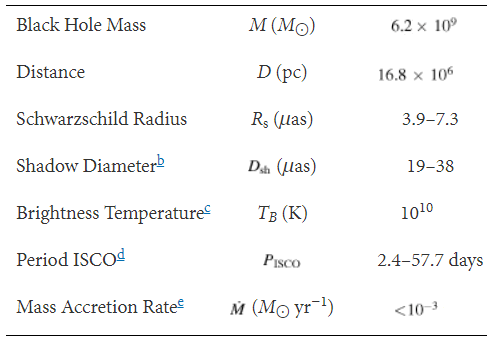
| Home Page | Overview | Site Map | Index | Appendix | Illustration | Preface | Contact | Update | FAQ |
 |
 |
M87 and its black-hole (also see "Space Fact"). An image of this black-hole is presented to the world by the Event Horizon Telescope(s) (EHT) in April, 2019. However, close examination reveals that the image is a shadow (actually a silhouette) formed by dark object against radio frequency background, and the whole picture is in false colors. It is stitched together with missing data filled in by some sort of educated guessing, a.k.a. "Bayesian Inference". |
Figure 05-02r1 M87, Black-Hole [view large image] |
Figure 05-02r2 M87 BH Parms |
The following shows the theoretical base and processing involved in the imaging. |
 /A) arc-sec (as) ~ 0.01 as. On the contrary, modern array of radio telescopes with baseline b ~ 109 cm (~ diameter of the Earth), can achieve resolution res ~ 2x105x(
/A) arc-sec (as) ~ 0.01 as. On the contrary, modern array of radio telescopes with baseline b ~ 109 cm (~ diameter of the Earth), can achieve resolution res ~ 2x105x( /b) as ~ 20x10-6as for radio wavelength
/b) as ~ 20x10-6as for radio wavelength  ~ 0.1 cm. Thus, the technique known as Very Long Baseline Interferometry (VLBI), is now available to image the black-hole in M87. Actually, such resolution is barely enough to view the structure of the accretion disk (usually makes of gas, dust and other stellar debris which do not emit light spontaneously), it would not be enough to see the details closer to the black-hole (see data in Figure 05-02-r2).
~ 0.1 cm. Thus, the technique known as Very Long Baseline Interferometry (VLBI), is now available to image the black-hole in M87. Actually, such resolution is barely enough to view the structure of the accretion disk (usually makes of gas, dust and other stellar debris which do not emit light spontaneously), it would not be enough to see the details closer to the black-hole (see data in Figure 05-02-r2).
 |
 for only one source. Diagrams (b), and (c) display progressively more complicated patterns (in 2-D) as more sources are involved. for only one source. Diagrams (b), and (c) display progressively more complicated patterns (in 2-D) as more sources are involved. |
Figure 05-02s1 Interference |
 driven by the rotation of the Earth. There are 8 major radio telescopes in the EHT. The measurements were taken in April 5, 6, 10 and 11, 2017 (see "Imaging the Central Supermassive Black Hole").
driven by the rotation of the Earth. There are 8 major radio telescopes in the EHT. The measurements were taken in April 5, 6, 10 and 11, 2017 (see "Imaging the Central Supermassive Black Hole").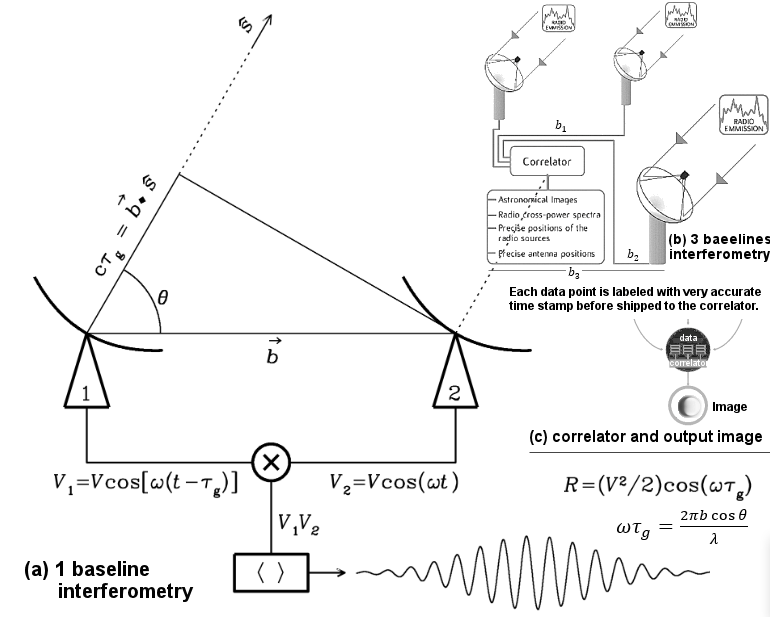 |
 |
 as. The path length is in unit of G as. The path length is in unit of G or 109 or 109  . There are lot of empty space in between the paths, meaning a lot of missing data to complete the imaging. These voids are filled up by an algorithm developed by Dr. Katie Bouman (see her TED Talk). . There are lot of empty space in between the paths, meaning a lot of missing data to complete the imaging. These voids are filled up by an algorithm developed by Dr. Katie Bouman (see her TED Talk). |
Figure 05-02s2 Interferometry |
Figure 05-02s3 VLBI |
 |

|
Figure 05-02t Black-hole Imaging |
 = 90o
= 90o  D = (1 - v2/c2)1/2, indicating that S0 << Se, the luminosity is reduced by the effects.
D = (1 - v2/c2)1/2, indicating that S0 << Se, the luminosity is reduced by the effects.  = 0o
= 0o  D = [(1 + v/c)/(1 - v/c)]1/2, indicating that S0 > Se, the luminosity is enhanced by the effect.
D = [(1 + v/c)/(1 - v/c)]1/2, indicating that S0 > Se, the luminosity is enhanced by the effect. 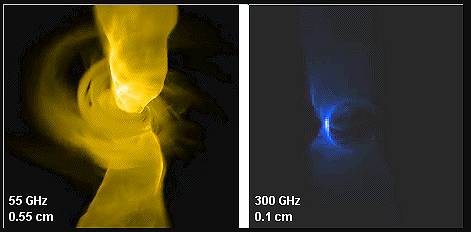 |
Earth) case, D = [(1 + v/c)/(1 - v/c)]1/2 which implies enhanced luminosity. For edge-on receding source v is replaced by -v so that D = [(1 - v/c)/(1 + v/c)]1/2 which implies reduced luminosity. However, even the approaching jet is absent in the M87 black-hole image because it is highly sensitive to observing wavelength as shown in the simulation images of Figure 05-02u and the accompanied video. The brightness of the jet becomes un-noticeable at the observational wavelength of 0.1 cm (see Figure 05-02u). |
Figure 05-02u Black-hole Jet |
 |
moves around because the environment around the black hole changes on a scale of several weeks. Strong magnetic fields stir the accretion disk and produce hotter spots that then orbit the black hole. See "The first-ever image of a black hole is now a movie". |
Figure 05-02w M87 Black Hole, |
In 2018, a separate team reported evidence of a blob of hot gas circling SgrA*, the Milky Way’s central black hole, over the course of around 1 hour. Because M87* is more than 1,000 times the size of SgrA*, the dynamics around M87* take longer to unfold. |
 |
It indicates that the emission occurs inside a magnetized plasma with lot of scrambling (reducing the degree of polarization). The pictures also show that the pattern varies in one day. Therefore, the maximum size of the emitting region would be no more than :  R ~ c x (seconds in one day) = (3x1010 cm/sec) x (86400 sec) ~ 2.6x1015 cm, R ~ c x (seconds in one day) = (3x1010 cm/sec) x (86400 sec) ~ 2.6x1015 cm, which is a little bit larger than the Schwarzschild radius of the M87 black hole Rs ~ 2x1015 cm ~ 100 AU. |
Figure 05-02x M87 Magnetic Field [view large image] |
1 AU = 1.5x1013 cm (distance from Sun to Earth) |
 |
 component (as shown in purple, Figure 05-02x,c). component (as shown in purple, Figure 05-02x,c). that produce the synchrotron radiation. that produce the synchrotron radiation. field, with the E-polarization at right angle (see Figure 05-02x,c or the video in Figure 05-02y). field, with the E-polarization at right angle (see Figure 05-02x,c or the video in Figure 05-02y). |
Figure 05-02y M87 Polarization [image, video] |
|
 direction. It is this B
direction. It is this B field that produces the observed polarization pattern as mentioned above.
field that produces the observed polarization pattern as mentioned above. component is also developed from the poloidal magnetic field (Figure 05-02x,e). It is the Lorentz force (Figure 05-02x,c) that holds the plasma together providing ultimately the source for the radiation and polarization.
component is also developed from the poloidal magnetic field (Figure 05-02x,e). It is the Lorentz force (Figure 05-02x,c) that holds the plasma together providing ultimately the source for the radiation and polarization. |
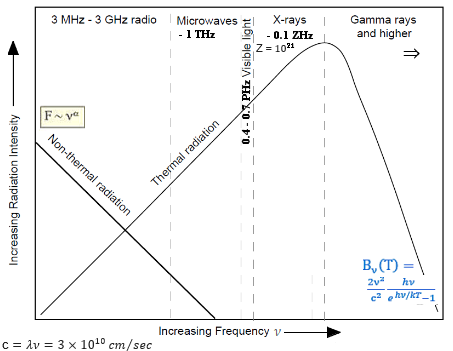 |
be a black hole (see Figure 05-02z1). However, there is no jet in the 300 GHz radio image of the M87 black hole taken by EHT in 2019 and its supposedly refined image in 2021. The disappearance can be explained by weak synchrotron (non-thermal) emission at the higher frequency of 300 GHz (see Figure 05-02z2). The jet re-appears in the 2023 radio image at 100 GHz from the Global Millimetre VLBI Array (GMVA). It shows the twisted helix close to the black hole from the accretion disk. Thus, it requires lower frequency to see the non-thermal jet; while higher frequency shows the jet by thermal radiation. |
Figure 05-02z1 M87 Jet |
Figure 05-02z2 Radiation Types [view large image] |
There is no jet ~ 300 GHz because both types of emission are weak near that point. (see video in Figure 05-02u, and the "Formation of Jet"). |
 |
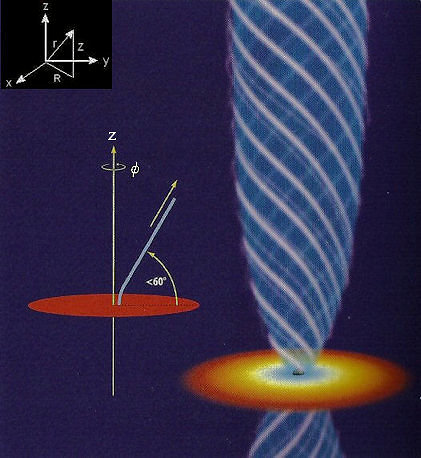 |
Figure 05-02z4 shows the helically shaped magnetic field composing 2 components, e.g., Bz and B along the z and along the z and  directions respectively. The thermal component moves along the z-axis collimated in the confined direction in a narrow beam. While only the lighter mass electrons can be bended over into the directions respectively. The thermal component moves along the z-axis collimated in the confined direction in a narrow beam. While only the lighter mass electrons can be bended over into the  direction emitting the non-thermal radiation (see synchrotron in Figure 05-02z5). direction emitting the non-thermal radiation (see synchrotron in Figure 05-02z5).
|
Figure 05-02z3 Thermal Emission from New-Born Stars [view large image] |
Figure 05-02z4 Magnetic Field |
 |
Synchrotron radiation is emitted by charged particles, usually electrons, moving at relativistic speeds in magnetic fields. In a magnetic field a charged particle is forced to circle around the field line in a helical path. An accelerating charged particle emits electromagnetic radiation that is radiated along the direction in which the particle is moving. A large population of relativistic particles moving in a magnetic field will radiate over a wide range of frequencies and has a high degree of polarization (Figure 05-02z5). |
Figure 05-02z5 Synchrotron Radiation |
 |
 |
A moving charged particle in a magnetic field would be reflected by the Lorentz force F = q (vxB), where q is the charge, v is the velocity, and B is the magnetic induction. The magnetic field can in turn be generated by current loop. In a region with uniform magnetic field, the curvilinear path of the charged particle becomes a circle as shown partially in Figures 05-02z6,7 and if the velocity has a component in the direction of the magnetic filed then the trajectory will be a helix as in the jets of many astronomical objects such as quasars or black holes; we can further identify the accretion disk to be the current loop generating the magnetic field. |
Figure 05-02z6 Synchrotron Polarization |
Figure 05-02z7 Synchrotron Spectrum [view large image] |
 on the orbital plane, and
on the orbital plane, and  is orthogonal to both n and
is orthogonal to both n and  . For synchrotron emission, we only see the radiation when the particle is moving towards us, i.e., when
. For synchrotron emission, we only see the radiation when the particle is moving towards us, i.e., when  ~ 0. Calculation shows that for a single electron, 7 times more power is radiated with the
~ 0. Calculation shows that for a single electron, 7 times more power is radiated with the  polarization than from
polarization than from  . The spectrum of synchrotron radiation from a single electron is shown in the diagram on the upper right of Figure 05-02z7.
. The spectrum of synchrotron radiation from a single electron is shown in the diagram on the upper right of Figure 05-02z7. between -3 and +2.5. A positive value of
between -3 and +2.5. A positive value of  indicates thermal emission in general. For :
indicates thermal emission in general. For : ~ -2 to -1,
~ -2 to -1, ~ -3 to -2,
~ -3 to -2, ~ -1.8 to +1,
~ -1.8 to +1, ~ -1 to +1,
~ -1 to +1, ~ -0.7,
~ -0.7, ~ -1.4 to -0.5.
~ -1.4 to -0.5.